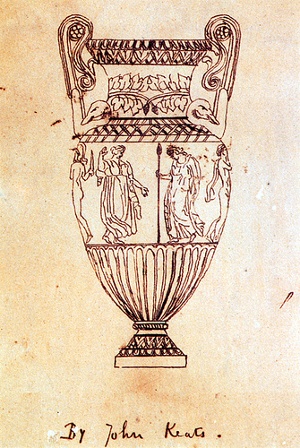John Keats, selected poems Contents
Ode on Indolence: Imagery, symbolism and themes
Imagery and symbolism in Ode on Indolence
The figures in the vision symbolise Love, Ambition and Poetry. The images Keats creates are of harmonious, gliding figures who fade and reappear within his vision/imagination. The images seem ‘strange’ to the speaker, having the beauty of ancient Greek art but arising from a world alien to the speaker, from which he feels excluded.
Other images the speaker uses to describe the figures include ‘Shadows’, ‘Ghosts’ and ‘Phantoms’. They are insubstantial and fleeting. They are also like performers in a ‘masque’, as if disguised and hatching a plot.
The world of lazy summer ‘indolence’ from which the figures have disturbed the speaker is depicted in a series of richly sensuous images such as ‘blissful cloud’, ‘drowsy noons’, ‘budding warmth’.
Investigating imagery and symbolism in Ode on Indolence...
- Why is the physical appearance of the figures significant?
- Why does their appearance seem to exclude the speaker from their world?
- What is the effect of the ‘shadows’ and ‘ghosts’ imagery?
- How successful do you think Keats is at using imagery to conjure up an afternoon of lazy summer indolence?
Themes in Ode on Indolence
Freedom or fame?
 The poem’s central theme is that the pleasant numbness of indolence which the speaker describes in the opening stanza is far preferable to the briefly intense but ultimately transitory allure of love, ambition and poetry.
The poem’s central theme is that the pleasant numbness of indolence which the speaker describes in the opening stanza is far preferable to the briefly intense but ultimately transitory allure of love, ambition and poetry.
The poem invites comparison with the Ode on a Grecian Urn. In that poem the carved figures on the vase evoke all the poet’s powers of delight, only to lead him to the realisation that the experience of such intense pleasure goes hand-in-hand with disillusion and suffering. In Ode to Indolence the robed forms of Love, Ambition and Poetry are merely unwanted intrusions on his ‘nothingness’, his spiritual lethargy, his ‘indolence’.
Only their third appearance provokes anything like a response, and even then the surge of recognition is immediately quenched. Just as the three figures fade, so does Keats’ interest in them diminish. He can find joy in nothing except ‘honeyed indolence’.
The requirements of creativity
Keats did not include this ode with the others, possibly because in writing it he was trying to capture the feelings he had experienced some weeks before, feelings which had passed. However, the poem is important for what it tells us about Keats’ beliefs about creativity. He accepts the numb, dull, indolent mood as an essential part of the creative process. He knew how important it was to let the mind lie fallow. Relentless activity and striving after ambition were not, for Keats, the path to success. As he says in stanza 4 of the ode, he wants to be shielded from the ‘voice of busy common-sense’ and appreciate life lived at a slower, quieter pace.
Keats was very suspicious of what worldly success might mean for a poet. If the only means of achieving fame was to write superficial and sentimental verse (characterised as being a ‘pet-lamb in a sentimental farce’), then Keats wanted none of it. Surrendering ambition also meant the banishment of ‘my demon Poesy’, but Keats seems to welcome this as a way of avoiding pain.
The role of art
In the other odes Keats is conscious that art may be beautiful and exercise a powerful hold over the emotions and imagination, yet he is also sensitive to the way in which it confronts human beings with their deepest selves. Art can force people to confront their own mortality, if only by comparing human transience with the permanence of art and its values.
In this poem Keats seems to be turning his back on the spiritual exploration which is such an important features of the Grecian Urn, Nightingale and Psyche odes in order to enter a purely private world of dreaming self-indulgence.
Investigating themes in Ode on Indolence...
- ‘The poem is important for what it tells us about Keats’ beliefs about creativity.’ What are these beliefs?
- How do the themes of this poem compare with those of the other odes?
- After reading the poem carefully, what do you understand Keats to mean by ‘indolence’?
- In what ways does the speaker find it preferable to love, ambition and poetry?
- Why, in particular, was Keats suspicious of ambition?
Recently Viewed
Related material
Scan and go
Scan on your mobile for direct link.